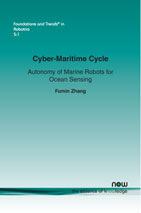Cyber-Maritime Cycle: Autonomy of Marine Robots for Ocean Sensing
By Fumin Zhang, Georgia Institute of Technology, USA, fumin@gatech.edu
Abstract
Marine robots are playing important roles in environmental sensing and ocean observation applications. This tutorial introduces the overall systems architecture and patterns for data streams that enable autonomy for marine robots in environmental sensing applications. The article proposes the concept of cyber-maritime cycle and surveys its use as a recent development in marine robotics. Supported by communication networks, autonomy can be achieved using at least three feedback loops in a cyber-maritime cycle, each running at different time scales or temporal frequencies. When information is circulating around the cycle, it is transformed between two representations: the Lagrangian view and the Eulerian view. Important functional blocks, such as mission planning, path planning, data assimilation, and data-driven modeling are discussed as providing conversions between the two views of data. The tutorial starts with an overview of enabling technologies in sensing, navigation, and communication for marine robotics. The design of experiment method is then reviewed to plan optimal sensing locations for the robots. The tutorial discusses a class of path planning methods that produces desired trajectories of marine robots while combating ocean current. The lack of an accurate Eulerian map for ocean current will lead to tracking error when robots attempt to follow the planned paths to collect Lagrangian data. The performance of robot navigation can be evaluated through the controlled Lagrangian particle tracking method, which computes trends and bounds for the growth of the tracking error. To improve the accuracy of the Eulerian map of ocean current, a data-driven modeling approach is adopted. Data assimilation methods are leveraged to convert Lagrangian data into Eulerian map. In addition, the spatial and temporal resolution of Eulerian data maps can be further improved by the motion tomography method. This tutorial gives a comprehensive view of data streams and major functional blocks underlying autonomy of marine robots.
Cyber-Maritime Cycle: Autonomy of Marine Robots for Ocean Sensing
Marine robots are being increasingly deployed in environmental sensing and ocean observation applications. The key challenges in mobile ocean sensing are to design and control the motion of the robots to collect Lagrangian data over a large spatial domain, and then convert these Lagrangian data streams into Eulerian spatial-temporal maps for scientific and operational benefits. This monograph introduces cyber maritime cycle as a collection of feedback loops where the flow of data is regulated by functional blocks of autonomy. As a new development, the split between the data-driven cycle and the geo-scientific modeling cycle allows the separation of data streams with different time and spatial scales. This separation allows the conversion between Lagrangian and Eulerian data representations to happen more frequently for navigation of marine robots.
This monograph introduces the overall systems architecture and patterns for data streams that enables autonomy for marine robots towards environmental sensing applications. It is an ideal reference for researchers, students or practitioners already doing research in this field, or planning to do so.
